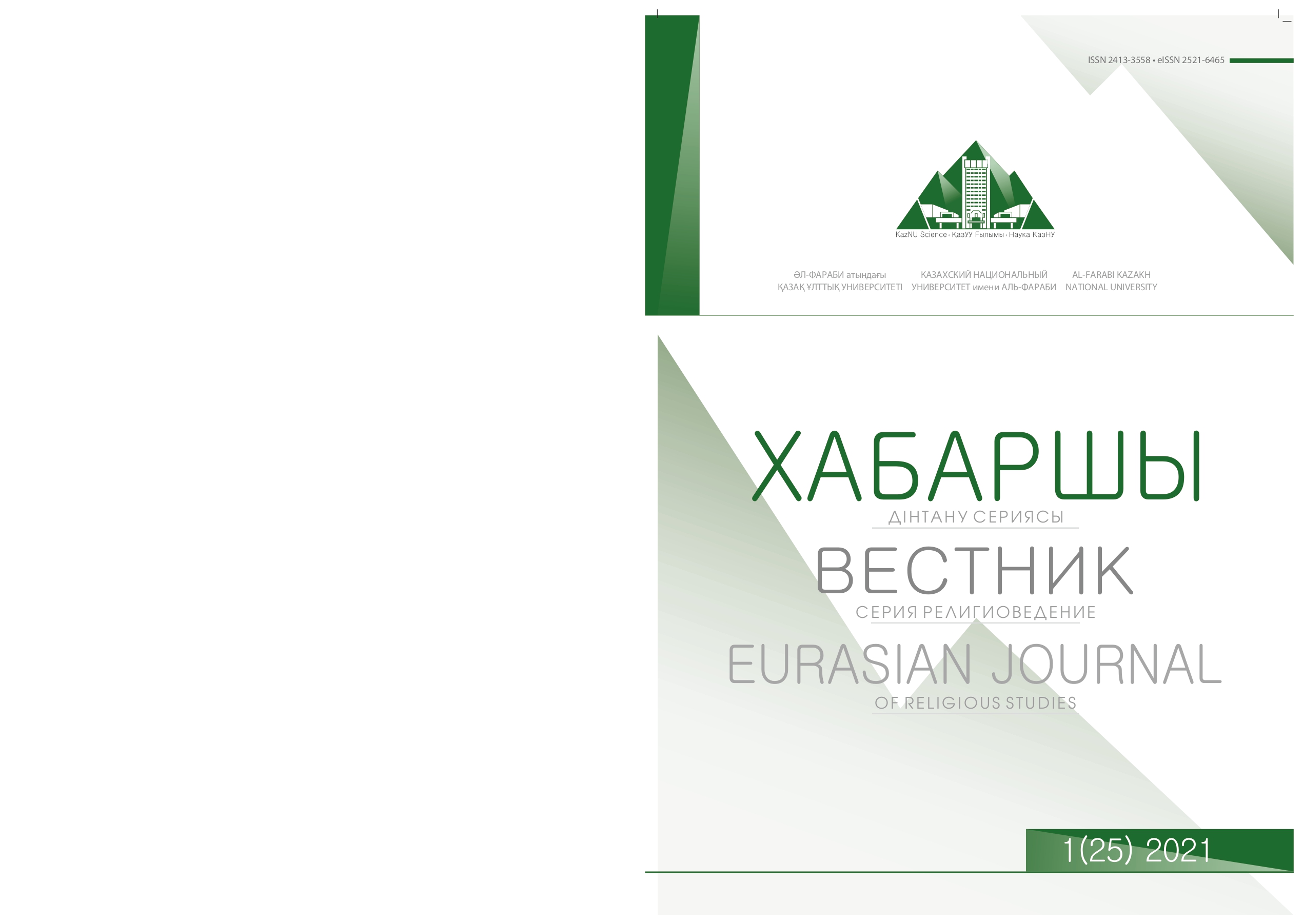Beliefs related to the ornaments of felt and woven carpets in the yurts of Kazakh people
DOI:
https://doi.org/10.26577//EJRS.2021.v25.i1.r6Keywords:
Felt and woven carpets, ornament, belief, totemism, magicAbstract
For many centuries, Kazakh people inhabited endless steppes and led a nomadic lifestyle. Cattle breeding was the foremost means of their subsistence. They grew camels, horses, cows, sheep, and used their milk, meat, wool and leather. They lived in portable felt accommodations and mastered handicraft necessary for their livelihood. Felt and woven carpets, the ornaments as well used in these carpets played a significant role among the other types of handicraft. According to scientists, ornaments were applied as a means of communication between people. Kazakh people preserved their language, religion, beliefs and traditions for thousands of years. The ornaments of handicraft products of Kazakh people are particularly classified into four groups; cosmogonic patterns (sun, star, moon), zoomorphic ornaments (animals, birds) considered as totems, floral ornaments (wood, flower, grain), and geometric ornaments (square, rhombus). Additionally, each ornament and the numbers used in these ornaments acquire with the meanings related to totemic symbols, magic and traditions. Therefore, the main purpose of the given work is to reveal the essence of the ornaments of felt and woven carpets related to the beliefs of our ancestors.
Key words: felt and woven carpets, ornament, belief, totemism, magic.References
Болысбаев, Д.С. және басқалары. «Ұлттық ою-өрнектің табиғаты мен наным-сенім ерекшеліктері». Л.Н. Гумилев атындағы Еуразия Ұлттық Университеті. Хабаршы. - Астана. №5. (120). 2017. б. 53-56.
Deniz, B. (2000). Türk Dünyasında Halı ve Düz Dokuma Yaygıları. Maltepe-Ankara: Atatürk Kültür Merkez
Yayınları. 284 s.
Deniz, B. (2005). Türk Dünyasında Ölümlük Halı ve Düz Dokuma Yaygı Geleneği. Bal-Tam Türklük Bilgisi-2, (s. 173-207). Prizren: Balkan Türkoloji Araştırmaları Merkezi Yayını.
Eliade, M. (2006). (2 b.) Şamanizm. İlkel Esrime Teknikleri. Çev. Birkan, İ. İstanbul: Kabalcı Yayınevi. 560 s.
Görgünay - Kırzıoğlu, N. (2001). Altaylar’dan Tunaboyu’na Türk Dünyası’nda Ortak Yanışlar (Motifler). Ankara:
Türk Tarih Kurumu Basımevi. 402 s.
Жәнібеков, Ө. «Жолайырықта». - Алматы: «Рауан». - 112 б.
Karataş, M. (2013). Türk Dilinde Yanış (Motif) Adları - Anadolu Sahası. (The Names Of Motives in Turkish Language – The Area of Anatolia). Türk Dili ve Edebiyatı. Doktora Tezi. Muğla Sıtkı Koçman Üniversitesi. Sosyal Bilimler Enstitüsü. Muğla. 429 s.
Кенжеахметұлы, С. «Қазақтың салт-дәстүрлері мен әдет-ғұрыптары». Алматы: «Атамұра». – 2 - басылым. 2013. - 384 б.
Қасиманов, С. «Қазақ халқының қолөнері». Алматы: Қазақстан. - 240 б.
Маргулан, А.Х. «Казахское народное прикладное искусство». - Алма-Ата: «Өнер». – 1 том. 1986. - 256 с.
Medevbekule, S. (1999). Sumağın Sırrı. (Sırmaq Şertken Sır). İlmek’e Yansıyan Şiir: Halı-Kilim (s. 159-165). Ankara: Ahmet Yesevi Üniversitesi Yardım Vakfı: Bilig Yayınları.
Niyetbay, U. (2019). Kazak Türklerinin Kültüründe Halı ve Düz Dokuma Yaygıları ile İlgili Söz Varlığı. (Vocabulary on Pile and Flat Woven Carpets in the Culture of Kazakh People). Türk Dili ve Edebiyatı. Doktora Tezi. Ardahan Üniversitesi. Sosyal Bilimler Enstitüsü. Ardahan, 306 s.
Schimmel, A. (1998). Sayıların Gizemi. (The Mystery of Numbers). Çev. Küpüşoğlu, M. İstanbul: Kabalcı Yayınevi. 337 s.
Солтанбаева, Г. «Мәңгілік өнер: Ою-өрнек тарихы». - Алматы: «Таймас». 2016. - 128 б.
Шойбеков, Р.Н. Қазақ тілінің қолөнер лексикасы. Фил.ғыл.док. ғылыми дәрежесін алу үшін дайындалған диссертация. – Алматы, 2006. – 307 б.
Шоқпарұлы, Д. «Қазақтың қол¬өнері». - Алматы: «Өнер». 2005. -176 б.
References
Alimbay, N. (Ed.). (2012-2013). Qazaqtyŋ Etnografiyalyq Kategoriyalar, Uğymdar men Atavlarınıŋ Dästürli Jüyesi.
(3-4 tom). Almaty: RPK Slon. 736 b. – 736 b.
Bolysbaev D.S. and others. (2017). Ulttyq oyu-örnektiŋ tabiğaty men nanym-senim erekşelikteri [Features of perception and natural character of the national ornament]. L.N. Gumilyov Eurasian National University. Habarşy. Astana, Kazakhstan, vol. 120 no. 5. pp. 53-56.
Janibekov, Ö. (1995). Jolayırıqta. Almaty: Ravan. - 112 b.
Kenjeahmetuly, S. (2013). Qazaqtıŋ Salt-Dästürleri men Ädet-Ğuryptary. (2 b.). Almaty: Atamura. 384 b.
Qasimanov, S. (1995). Qazaq Halqınıŋ Qolöneri. Almaty: 240 b.
Margulan, A. (1986). Kazahskoye Narodnoye Prikladnoye İskusstvo. (1 tom). Alma-Ata: Öner. 256 b.
Soltanbayeva, G. (2016). Mäŋgilik Öner: Oyu-Örnek Tarihy. Almaty. 128 b.
Şokparuly, D. (2005). Qazaqtıŋ Qolöneri. Almatı: Öner. 176 b.
Şoybekov, R.N. (2006). Qazaq Tiliniŋ qolöner leksikasy. Fil.ğıl.dok. ğılımiy därejesin aluv üşin dayındalğan dissertatsiya. – Almaty, 307 b.




